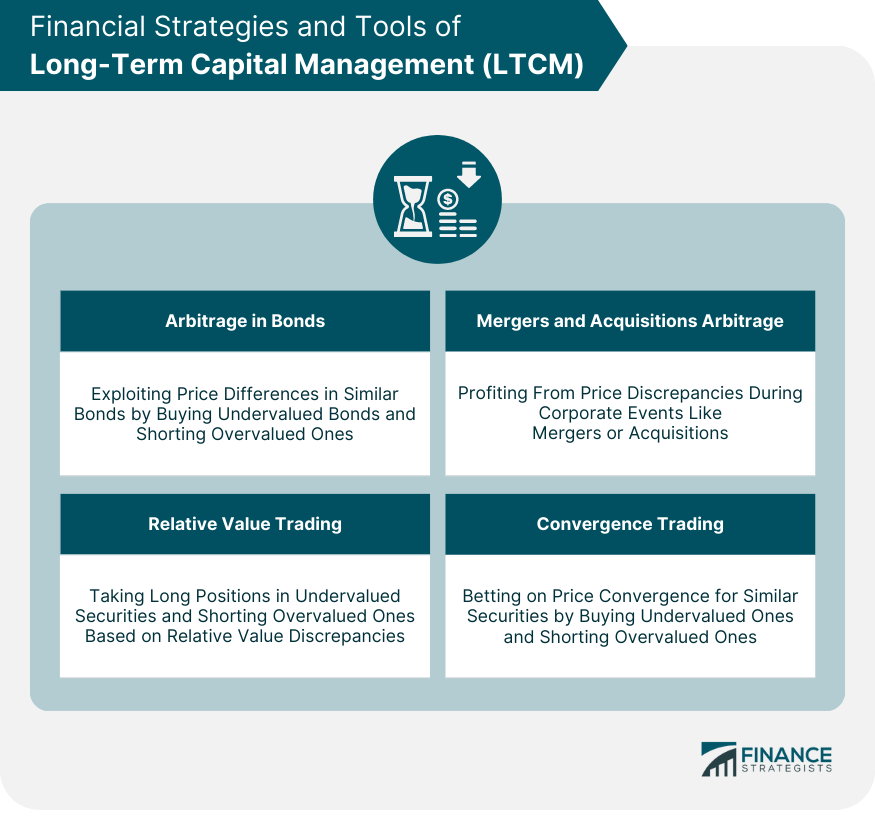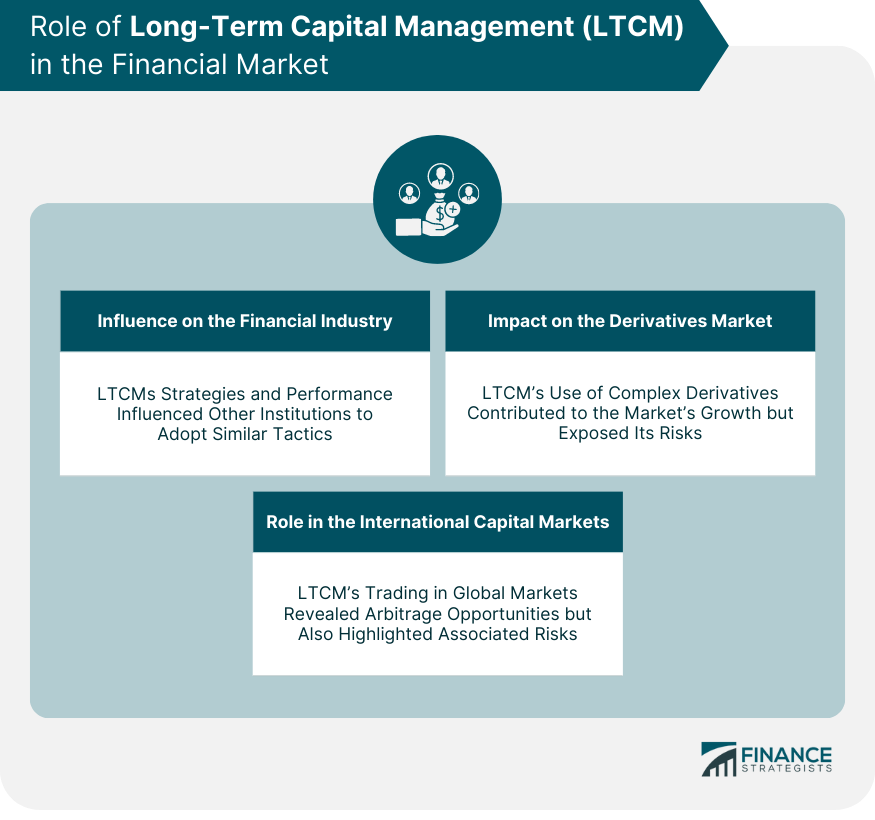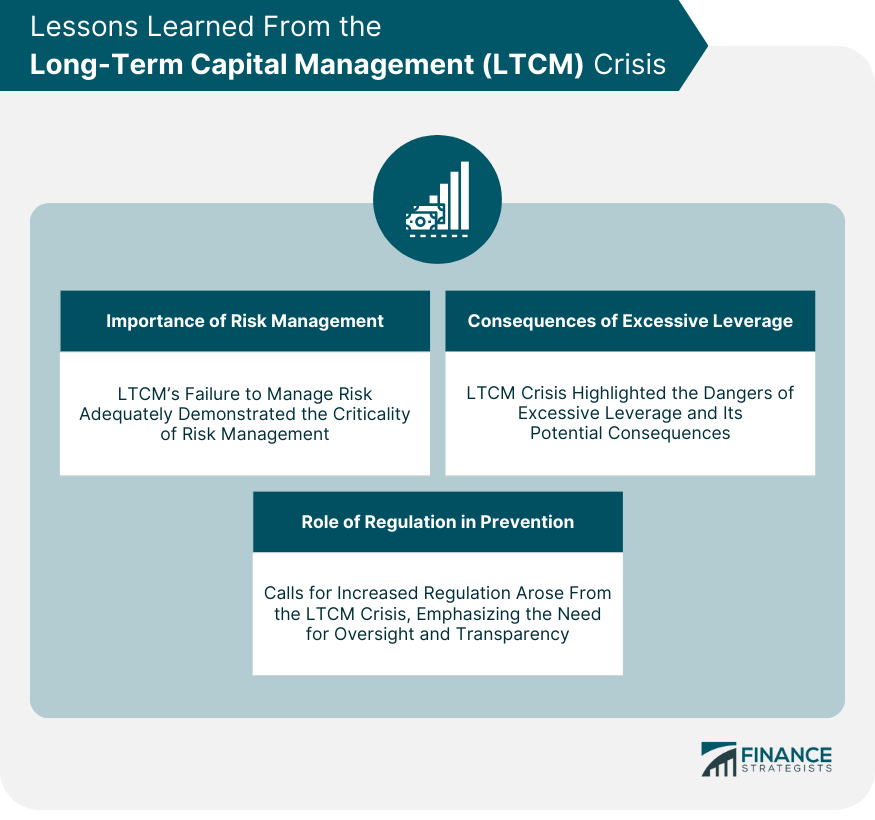Long-Term Capital Management (LTCM) was a hedge fund established in 1994, which used trading strategies to exploit market inefficiencies. The fund became famous for both its high-profile success in the mid-1990s and its spectacular failure in 1998, that led to a significant financial crisis. The philosophy of LTCM was rooted in the belief that markets are efficient in the long run but can exhibit discrepancies in the short term. These discrepancies, according to LTCM, provided opportunities for high returns through carefully calculated strategies. This belief, combined with a high-leverage model, initially led to incredible success, only to precipitate a downfall later. The founding team of LTCM consisted of a group of elite individuals with extensive experience in finance, economics, and academia. This included two Nobel laureates in economics, Myron S. Scholes and Robert C. Merton. John W. Meriwether, a former vice-chairman, and head of bond trading at Salomon Brothers, was also a key figure in the founding of LTCM. The business model of LTCM was based on convergence trading. This strategy involved buying undervalued securities and selling overvalued ones, expecting that prices would eventually converge to fair values. To implement this strategy, LTCM used sophisticated mathematical models and substantial leverage. One of LTCM's primary strategies was arbitrage in bonds. This involved taking advantage of small price differences in bonds with similar characteristics but slightly different prices. By purchasing the undervalued bond and shorting the overvalued one, LTCM expected to profit when the prices converged. LTCM also engaged in mergers and acquisitions arbitrage, which involved taking positions in companies undergoing corporate events, such as mergers or acquisitions. The aim was to profit from the price discrepancies between the current market price and the price expected once the corporate event had been completed. Relative value trading was another tool used by LTCM. This strategy involved taking a long position in an undervalued security while shorting an overvalued one. LTCM believed that discrepancies in relative values offered profitable opportunities. Convergence trading was at the heart of LTCM's strategy. This involved betting on the convergence of prices for similar securities. In practice, this meant purchasing securities that were undervalued and shorting those that were overvalued, with the expectation that their prices would converge over time. In its early years, LTCM experienced phenomenal success. By the end of 1995, it had earned a return of over 40% after fees. This exceptional performance continued through 1996 and 1997, with returns exceeding 40% and 20%, respectively. Among the notable investments of LTCM were positioned in interest rate swaps and options on volatility. These investments, combined with the fund's high-leverage model, led to substantial returns in the initial years. For instance, LTCM's investment in European bonds in 1994, exploiting mispricing between Italian and German bonds, led to a significant profit. Several factors contributed to LTCM's early success. The fund's use of sophisticated mathematical models, the reputation of its founders, and innovative trading strategies all played a role. Additionally, the relatively stable financial environment of the mid-1990s allowed LTCM's strategies to flourish. LTCM had a profound influence on the financial industry. Its innovative strategies and impressive returns attracted significant attention, leading many other financial institutions to develop similar strategies. Moreover, the fund's later collapse served as a stark reminder of the risks associated with high leverage and lack of transparency. LTCM was a significant player in the derivatives market. Its trading strategies often involved complex derivative positions, which contributed to the growth and development of this market. However, the fund's collapse also exposed the risks associated with derivative trading and led to calls for increased regulation and oversight. LTCM's strategies also involved significant trading in international capital markets. The fund's activities in these markets, particularly its trading in European bonds, helped to highlight the potential for arbitrage opportunities across different markets. However, LTCM's collapse also underscored the risks associated with such cross-border trading strategies. The 1998 financial crisis was precipitated by Russia's default on its sovereign debt. This event sent shockwaves through international financial markets, leading to a flight to quality, with investors seeking safer investments. This unexpected market movement disrupted LTCM's strategies, which relied on stable market conditions and the convergence of prices. As a result, LTCM experienced significant losses, eventually leading to its downfall. Leverage played a significant role in LTCM's downfall. The fund had borrowed heavily to amplify its investments, a strategy that magnified gains during good times but also magnified losses during downturns. When the 1998 financial crisis hit, LTCM's highly leveraged positions led to substantial losses, eventually threatening the solvency of the fund. LTCM made several mistakes and miscalculations that contributed to its downfall. One key error was underestimating the potential for market disruptions and over-relying on historical data and models. The fund also failed to adequately manage its risk, maintaining highly leveraged positions without sufficient safeguards. In the face of LTCM's impending collapse, the Federal Reserve intervened to coordinate a bailout. The Fed's concern was that the failure of LTCM could have systemic implications, potentially leading to a broader financial crisis. Therefore, it facilitated a rescue package involving several major financial institutions. Major financial institutions, including Goldman Sachs, Merrill Lynch, and J.P. Morgan, played a crucial role in the bailout of LTCM. These institutions, along with others, contributed to a $3.6 billion rescue package, taking ownership of LTCM in the process. The bailout of LTCM had a significant impact on financial markets. It helped to stabilize the markets in the short term, preventing a broader financial crisis. However, it also sparked debates about moral hazard, with some critics arguing that it could encourage reckless behavior by financial institutions. The LTCM crisis highlighted the importance of risk management. The fund's downfall was largely due to its failure to adequately manage its risk, particularly its exposure to market disruptions and its high leverage. This served as a stark reminder of the potential consequences of inadequate risk management. The LTCM crisis also underscored the risks associated with excessive leverage. While leverage can amplify gains, it can also magnify losses, potentially leading to significant financial distress. This was a key lesson from the LTCM crisis. The LTCM crisis led to calls for increased regulation and oversight of hedge funds and other financial institutions. Critics argued that the lack of transparency and oversight had contributed to the crisis, highlighting the need for improved regulation. After the bailout, LTCM was gradually wound down, with its assets sold off to repay its creditors. By 2000, the fund was effectively dissolved. The founders and key personnel of LTCM went on to various roles in finance and academia, with some founding new hedge funds. LTCM left a lasting legacy in the financial industry. Its innovative strategies and its spectacular downfall had a profound influence on the industry, shaping practices and attitudes toward risk and leverage. The crisis also highlighted the systemic risks associated with large, highly leveraged financial institutions, leading to increased attention to these risks by regulators and market participants. The LTCM crisis had a significant impact on financial regulations. It highlighted the risks associated with unregulated hedge funds and the potential for systemic risk arising from their activities. As a result, regulators around the world implemented stricter regulations for hedge funds and other financial institutions aimed at improving transparency, limiting leverage, and enhancing risk management. In retrospect, it's clear that LTCM's strategies were both innovative and risky. They relied on sophisticated mathematical models and the assumption of market efficiency. However, they also involved significant leverage and were vulnerable to market disruptions. Today, the story of LTCM is often seen as a cautionary tale about the risks of excessive leverage and over-reliance on models. While LTCM's strategies were initially highly successful, their ultimate failure underscores the importance of risk management and the potential for unforeseen market events. LTCM's influence on modern financial practices is significant. The fund's strategies, particularly its use of derivatives and its focus on arbitrage opportunities, have been widely adopted by other hedge funds and financial institutions. However, the lessons from LTCM's downfall have also led to a greater emphasis on risk management and caution regarding leverage. Long-Term Capital Management (LTCM) was a hedge fund that rose to prominence in the mid-1990s with its innovative trading strategies, only to experience a spectacular downfall in 1998. The fund's success was rooted in exploiting market inefficiencies through carefully calculated strategies such as arbitrage, mergers and acquisitions arbitrage, relative value trading, and convergence trading. LTCM's early success was fueled by its use of sophisticated mathematical models, the reputation of its founders, and the relatively stable financial environment of the time. However, the fund's downfall was triggered by the 1998 financial crisis, Russia's default on its sovereign debt, which disrupted LTCM's strategies and exposed the risks associated with its high leverage. The Federal Reserve orchestrated a bailout involving major financial institutions, emphasizing the need for risk management and regulation. LTCM's legacy includes a lasting impact on the financial industry, increased attention to systemic risks, and a cautionary tale about the dangers of excessive leverage and over-reliance on models.What Is Long-Term Capital Management (LTCM)?
Founding Team and Initial Business Model of LTCM
LTCM's Financial Strategies and Tools
Arbitrage in Bonds
Mergers and Acquisitions Arbitrage
Relative Value Trading
Convergence Trading

Success Phase of LTCM
Initial Years of Operation and Success
Notable Investments and Returns
Factors Leading to the Success of LTCM
Role of LTCM in the Financial Market
Influence on the Financial Industry
Impact on the Derivatives Market
Role in the International Capital Markets

Downfall of Long-Term Capital Management (LTCM)
1998 Financial Crisis: Causes and Implications for LTCM
Role of Leverage in LTCM's Downfall
Mistakes and Miscalculations by LTCM
Bailout of LTCM
Federal Reserve's Intervention
Role of Major Financial Institutions in the Bailout
Impact of the Bailout on the Financial Markets
Lessons Learned From the LTCM Crisis
Importance of Risk Management
Consequences of Excessive Leverage
Role of Regulation in Preventing Similar Crises

Aftermath of Long-Term Capital Management (LTCM)
What Happened to LTCM After the Crisis
Legacy of LTCM in the Financial Industry
How the LTCM Crisis Influenced Subsequent Financial Regulations
LTCM: Reflections and Contemporary Perspectives
Retrospective Analysis of LTCM's Strategies
Contemporary Perspectives on LTCM
LTCM's Influence on Modern Financial Practices
Final Thoughts
Long-Term Capital Management (LTCM) FAQs
LTCM's strategy involved using sophisticated mathematical models to identify and exploit market inefficiencies. The fund primarily focused on convergence trading and arbitrage opportunities.
LTCM failed due to a combination of high leverage and significant market disruption caused by the 1998 Russian financial crisis. The fund's strategies were not equipped to handle such an event, leading to substantial losses.
LTCM had a significant impact on the financial markets. Its success influenced other hedge funds to adopt similar strategies. However, its failure led to a financial crisis and highlighted the systemic risk posed by large, highly leveraged financial institutions.
The LTCM crisis led to increased regulation and oversight of hedge funds and other financial institutions. It highlighted the need for improved transparency, risk management, and limits on leverage.
The LTCM crisis highlighted the importance of risk management, the potential risks of excessive leverage, and the need for financial regulation. It also underscored the potential for unforeseen market events to disrupt financial strategies.
True Tamplin is a published author, public speaker, CEO of UpDigital, and founder of Finance Strategists.
True is a Certified Educator in Personal Finance (CEPF®), author of The Handy Financial Ratios Guide, a member of the Society for Advancing Business Editing and Writing, contributes to his financial education site, Finance Strategists, and has spoken to various financial communities such as the CFA Institute, as well as university students like his Alma mater, Biola University, where he received a bachelor of science in business and data analytics.
To learn more about True, visit his personal website or view his author profiles on Amazon, Nasdaq and Forbes.















